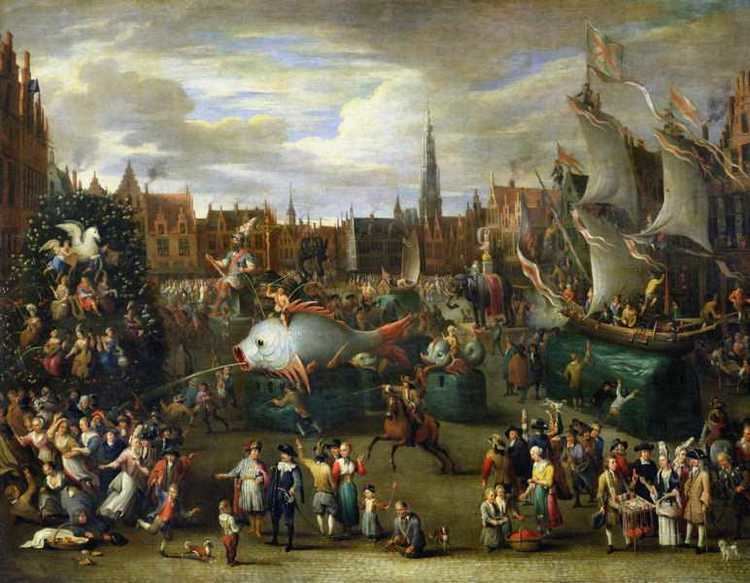 | ||
Ommegang or Ommeganck (Dutch: "walk around" (the church, village or city), [ˈɔməˌɣɑŋ]) is the generic name for various medieval pageants celebrated in what is now Belgium, in the Netherlands, and in northern France.
Contents
Ommegang of Antwerp
The Ommegang in Antwerp originated in the 14th century and is held on 15 August. There were two Ommegang processions held in Antwerp each year:
In the 15th, 16th and 17th century the Ommegang of Antwerp was the most important in Flanders. The "Onze Lieve Vrouwommegang" consisted originally of two events: the first celebrated the religious feast of the Assumption of Mary. The second was a large, opulent secular participation of the guilds, crafts and chambers of rhetoric, each of which contributed a float to a procession through the streets of Antwerp. Some floats contained references to events of the preceding year. There was considerable rivalry between the guilds in their efforts to provide the most splendid display.
In the 17th century the Ommegang of Antwerp comprised these elements in the following order:
The Ommegang in Antwerp has been depicted in several paintings by Antwerp artists such as Erasmus de Bie, Alexander van Bredael and Pieter van Aelst.
Ommegang of Brussels
The Ommegang of Brussels is celebrated every July in Brussels. According to legend the origin of the Ommegang of Brussels goes back to a local devout woman named Beatrijs Soetkens. She had a vision in which the Virgin Mary instructed her to steal the miraculous statue of ‘Onze-Lieve-Vrouw op ‘t Stocxken’ (Our Lady on the little stick) in Antwerp, bring it to Brussels and place it in the chapel of the Crossbow Guild. The woman stole the statue and through some miraculous events was able to bring it to Brussels by boat in 1348. The statue of Mary was then solemnly placed in the chapel and venerated as the patron of the Guild. The Guild promised to hold an annual procession, called an 'Ommegang', in which the statue was carried through Brussels. However, what was originally a religious procession, took on through the following decades gradually a more worldly outlook. From the mid-sixteenth century, the Ommegang not only celebrated the miraculous legend, but became intertwined with the Joyous Entry of Holy Roman Emperor Charles V. The Ommegang of Brussels thus developed into an important religious and civil event in the annual calendar of Brussels.
Other examples of Ommegang
Another famous Ommegang in Belgium is the Ros Beiaard Ommegang in Dendermonde. In this ommegang, which is held every ten years, a giant wooden horse is displayed in the town centre. Four boys from the same family of Dendermonde have the honour to 'ride' the horse while it is on display.
The most infrequent Ommegang, only held once every 25 years, is part of the Cavalcade of Hanswijck in Mechelen. The Ommegang element evolved from the annual procession around the city walls held since 1330 as a token of gratitude to Mechelen's patron Saint Rumbold who 'miraculously' ended a siege. A Ros Beiaard which is smaller but older than the one in Dendermonde is mounted in the same manner and the 'family' of six city giants stands out. As in other cities, the commemoration became located largely within its centre.
The annual Ducasse at Ath has one of the largest of city giants: Gouyasse (Goliath).
Many of these traditions in Belgium and (with only two exceptions, formerly Flemish northern) France are protected as an oral and immaterial cultural legacy by UNESCO, with reference to physical artefacts such as Giants and Dragons (the latter referring to any kind of mythical animals) carried by humans.
